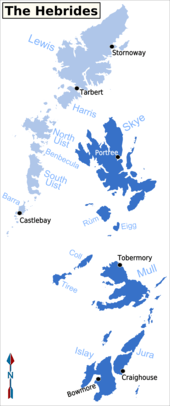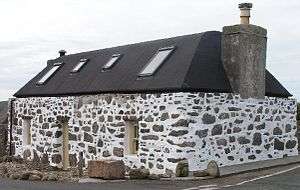Hebrides
The Hebrides (Scottish Gaelic: Innse Gall) are the most beautiful part of the British Isles. The landscape is rocky and mountainous, but also lush and verdant - due in no small part to the large amounts of rain which tend to fall. However, this should not put off the potential visitor, and many would say that the Hebrides are just not the same without at least some drizzle - just bring some rainclothes! When the sun does shine however, the resulting vistas are almost always stunning.

The Outer Hebrides have some of the most spectacular beaches, not just in Europe but in the world. Much of the west side of the 130 mile long string of islands is one virtual long deserted and clean beach. Incredible beaches can be found on Barra, South Uist, North Uist, Berneray, Harris and Lewis.
Many of the other Hebridean islands, such as Coll, Tiree, Islay and Mull also have quite breathtaking beaches. Due to the beaches, tides and weather, the Hebrides are rapidly becoming a major fixture on the sea sports map, especially for surfing.
Regions

| Inner Hebrides Includes: Skye, Mull, Lismore, Islay, Jura, Coll, Tiree, Colonsay and Small Isles. |
| Outer Hebrides Includes Lewis and Harris, Berneray, North Uist, Benbecula, South Uist, Eriskay, Barra and St Kilda. |
Towns and villages
- 🌍 Stornoway (Gaelic: Steòrnabhagh) – on the Isle of Lewis
- 🌍 Bowmore (Gaelic: Bogh Mòr, The Big Bend) – on Islay
- 🌍 Castlebay (Gaelic: Bàgh a' Chaisteil) – the main village on Barra
- 🌍 Craighouse (Gaelic: Taigh na Creige) – on the Isle of Jura
- 🌍 Portree (Gaelic: Port Rìgh) – on Skye
- 🌍 Tarbert (Gaelic: An Tairbeart) – the main village in Harris
- 🌍 Tobermory (Gaelic: Tobar Mhoire) – on Mull
Get in
The Hebrides covers a very large area. Careful examination of timetables is often prudent. However, it is possible to travel around the Outer Hebrides without your own transport. The nearest large city on the mainland is Glasgow, some way to the south east.
Most of the islands can be reached by ferries or other boats. Most of these ferries are operated by Caledonian MacBrayne, otherwise known as CalMac, who have a full set of timetables and additional information on their website. Ferries are relatively cheap for foot passengers, but very expensive for motor vehicles.
The port of Oban on the mainland is a main transport hub, with a connection to the West Highland Railway and ferry connections to Barra, South Uist, Mull, Coll, Tiree, Colonsay and Lismore. Further north, the port of Mallaig has ferry services to the Small Isles - Canna, Rum, Eigg and Muck, as well as Skye. It is also possible to drive onto Skye using the bridge at the Kyle of Lochalsh.
The port of Uig on Skye has short ferry connections to the Outer Hebrides islands of North Uist and Harris. Ullapool, in the far northwest of Scotland, has a daily ferry connection to Stornoway on the island of Lewis.
There are airports in Stornoway in Lewis, Benbecula and Barra as well as several inner Hebridean islands. Flights are all operated by Loganair, except for a couple by Eastern in addition. These airports provide direct flights to Aberdeen, Edinburgh, Glasgow and Inverness. The airport in Barra is one of the most spectacular in the world, with planes landing on a three-mile beach at low tide. These flights however are often delayed due to weather problems, and are often very turbulent, and therefore are not for nervous flyers, due to small planes being used. The safety record however, is immaculate.
Many signs are bilingual, being in both English and Gaelic. In some parts of the Hebrides (i.e. north of Stornoway), most people speak Gaelic as their native language. The locals sometimes appreciate you learning a few Gaelic phrases as a sign of politeness - Goiresan (Toilet or WC) may come in useful!
Get around
The road networks are small but tolerable and link all major settlements on larger islands. Many of the most beautiful roads are single track with passing places.
Local bus companies provide good bus links, although there are no services on Sundays in some areas.
Hitchhiking is usually a good option where there are no buses and is much safer and easier than on the mainland.
The best way to enjoy these islands is almost certainly on foot - the hiking opportunities are excellent, and the most beautiful and tranquil spots are often (unsurprisingly) located far from roads. The Isle of Skye is home to the Cuillins, the famous glacially cut mountain range. The lower reaches provide excellent walking terrain, while assailing the peaks is harder and depending on the mountain in question fit for very keen walkers up to skilled mountaineers with full climbing equipment.
See
The Northern Lights are frequently visible from the Hebridean islands. Due to the low population, there is an absence of light pollution to affect this, and other night time views.
The Quiraing on Skye is a marvellous landscape formed by massive land slips that step from cliffs to sea. It includes the iconic 'Old Man of Storr' rock stack. The Cuillins in southern Skye are a spectacular mountain range offering views across to the mainland and rugged walking and climbing.
The Outer Hebrides - or Western Isles - are home to thousands of migratory wading birds from autumn through winter. In spring the delightful 'Machair' blooms along the western shorelines: one of the few places in the world where this profusion of coastal spring flowers can be found. Wild, windswept beaches abound along the west coast, while along the east coast numerous sea lochs and freshwater lochs create a landscape that is as much water and sea as it is land.
Sleep

Accommodation is often most rewarding if you stay somewhat off the beaten track - most villages will have chalets or bed and breakfasts. These will probably be cheaper than those in the more tourist-oriented areas. Due to the steep cost of advertising, most accommodation is not listed in official tourist brochures or through the monolithic VisitScotland service. Instead, ask locally, search on the web, or look at more locally focused community websites.
Cope

The wetness also encourages midges on most of the islands, although these often last for just a few weeks of "summer" after the middle of June. Insect repellent or head nets (available widely) are useful, although if not walking on grassland or when dry underfoot this will be much less of a problem.
In winter, the high latitudes in the north of Scotland means it is often cold, even in spring and autumn. Snow may be expected to last late and start falling early, on the high ground - say, November to March. Some might say don't bother visiting in winter as it's too cold. Those same people will never witness Scotland at its most beautiful, where the sun striking the snow-covered peaks is truly a sight to behold.
Stay safe
People are very friendly in this part of Britain, and any form of crime (which is very unlikely) is likely to be big news in the community.
Many of the Hebridean islands are remote and sparsely populated, however, and the weather can change very rapidly; it is therefore important to be well prepared before venturing onto the hills or moors.
Go next
There are several other groups of Scottish islands, which have some similarities to and some differences from the Hebrides.
- Orkney Islands an archipelago of some 70 islands just north of the North West tip of the Scottish mainland.
- Shetland Islands, some 100 islands (15 inhabited) to the north of the Orkney Islands.
- The islands in the Clyde, principally the Isle of Arran and the Isle of Bute.